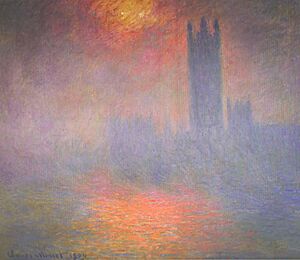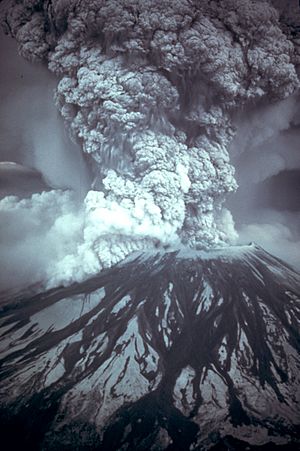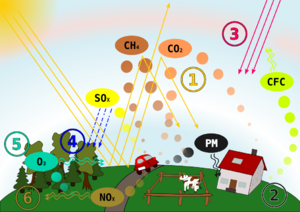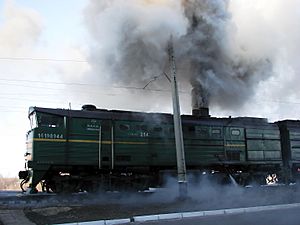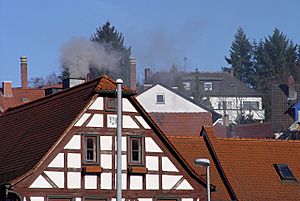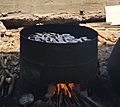Air pollution facts for kids
Air pollution is when the air around us gets dirty with harmful gases or tiny particles. It's a type of pollution that makes the air unhealthy to breathe. This usually happens because of smoke or other bad gases, like those from burning things.
Even a long time ago, people noticed air pollution. About 2,000 years ago, the Romans complained about smoky air in their cities. Today, many big cities around the world have dirty air. Air pollution is a big problem for human health and for Earth's many ecosystems (like forests and oceans).
Contents
What is Air Quality?
Air pollution can be in the form of a gas, a liquid, or tiny solid pieces. Scientists can also sort pollutants by their chemicals, like oxides (which have oxygen) or acids.
Some pollutants come from natural sources. These include dust, salt from the sea, volcanic ash and gases from volcanoes, smoke from forest fires, and pollen from plants.
Primary and Secondary Pollutants
Air pollutants are usually called either primary or secondary.
- Primary pollutants are put directly into the air. This can be by humans or by nature.
- Examples: Exhaust fumes from cars, soot (black powder) from smoke, dust storms, and ash from volcanic eruptions.
- Secondary pollutants are made when different chemicals mix in the air. This often happens when primary pollutants react with other things, like water vapor or even sunlight.
How Humans Cause Air Pollution
Most air pollution made by humans today comes from transportation. Cars, for example, create about 60% of human-made air pollution. The gases from car exhaust, like nitrogen oxide, help create smog and acid rain.
Pollution from Industries
Many factories and power plants burn fossil fuels (like coal or oil) to get energy. Burning these fuels releases a lot of oxides into the air. For example, burning fossil fuels makes 96% of the sulfur oxides in the atmosphere. Some industries also create chemicals that make poisonous fumes.
Pollution Inside Buildings
Air pollution doesn't just happen outside. The air inside homes, schools, and other buildings can also be polluted. Sometimes, the air inside a building, especially if windows are closed, can be worse than the air outside. Many everyday items can pollute the air, such as new carpets, paints, building materials, and furniture.
Acid Rain
Acid precipitation is rain, sleet, or snow that contains acids from air pollution. When fossil fuels are burned, they release oxides into the air. These oxides mix with water in the atmosphere to form acid, which then falls as precipitation.
Acid rain can harm living things like fish and trees by making their environment too acidic. It can also damage buildings made of limestone and concrete.
The Ozone Layer Problem
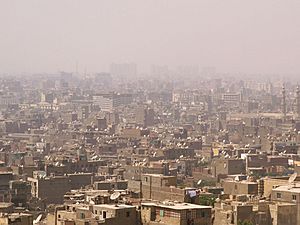
The ozone layer is high up in the sky, in the stratosphere. It protects life on Earth from the sun's harmful ultraviolet rays. However, in the 1970s, scientists discovered that some chemicals released into the atmosphere were turning ozone into oxygen. This means more harmful ultraviolet rays could reach Earth. In the 1980s, scientists found that the ozone layer above the South Pole had become much thinner.
How Air Pollution Affects Health
Air pollution can cause many health problems, especially for children, older people, and those with allergies. For example, studies have shown that air pollution from cars might be linked to some deaths from pneumonia.
The World Health Organization has said that millions of people have died because of health problems caused by air pollution. Some common problems include:
|
|
|
Effects on Farming
Air pollution can also affect how well crops grow. A report from India in 2014 showed that air pollution in 2010 had cut the amount of crops harvested by almost half in some areas compared to 1980. On the other hand, when air quality gets better, crops can sometimes grow better too.
Interesting Facts About Air Pollution
- Air pollution comes from both human activities and natural sources. Factories, mining, vehicles, forest fires, volcanic eruptions, and wind erosion can all cause it.
- About 92% of the world's population lives in areas where air pollution is higher than what is considered safe.
- Breathing polluted air is thought to shorten an average human life by 1-2 years.
- Babies whose mothers live in areas with heavy traffic have a higher risk of being born with weaker lungs.
- Air pollution is more dangerous for children because their bodies are smaller and their lungs are still developing.
- A child's IQ can be negatively affected by air pollution.
- ADHD can get worse or even be caused by certain chemicals in polluted air.
- Waiting in traffic and breathing in the pollution is thought to increase the chance of a heart attack.
- The 1952 Great Smog of London is believed to have killed 8,000 people.
- Scientists have estimated that by 2050, six million people per year could die because of air pollution.
- Many large cities control how much pollution vehicles can release to help clean the air.
- Deforestation (cutting down forests) is a major cause of air pollution because trees help clean the air.
Images for kids
-
Air pollution from a coking oven.
-
Controlled burning of a field outside of Statesboro, Georgia, in preparation for spring planting.
-
Dust storm approaching Stratford, Texas, in 1935.
-
Air quality monitoring, New Delhi, India.
-
Using public transport like trams can help reduce air pollution.
-
Nets are often used to reduce dust from construction sites.
-
Before special equipment was installed, the emissions from this power plant in New Mexico had too much sulfur dioxide.
See also
 In Spanish: Contaminación atmosférica para niños
In Spanish: Contaminación atmosférica para niños


